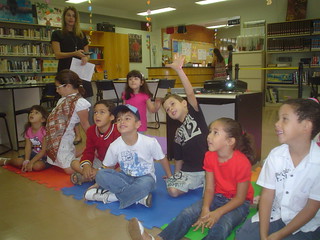Have you ever had a student in your class struggling to survive until the class is over? Or having a blank when speaking even when they volunteered to participate? How would you deal with it? This situation can be quite uncomfortable for everyone in class and can be a good reason for a student to definitely quit a project of learning a foreign language.
Having difficulties speaking in class or exposing your ideas in another language to others is not uncommon, but suffering almost the whole class period can hamper the learning process and influence the atmosphere of even a light and productive class. It´s not easy, if not impossible, to measure the degree of stress one is going through, but there are some steps you can take to help students deal with this stress and feel more comfortable in class.
First, the problem has to be spotted. Many times, what seems to be an ordinary difficulty is, in fact, a freezing sensation that blocks a student´s thoughts and exposes them to their peers. This happened by chance in one of my groups this semester. A student of mine confessed at the end of a class that she had been suffering the whole class because she was afraid of speaking and that it was always a relief to see that the class was over. I was really surprised. I had noticed she had some difficulties expressing herself, but not that it was so painful. Helping her find the words that escaped from her mind while she was speaking wasn´t always enough to enable her to express her whole message, and adding comments to her broken speech to call the groups` attention to me and ”save” her from her long pauses and embarrassment wasn´t a solution to this problem either. So, this situation became a challenge to me.
The next step is to approach the student and find out what is causing all the anxiety. This way, the student can not only become aware of the real sources of the problem and face it, but also see the teacher as a support they can count on. Most frequently, the fear of speaking to a group, being on the spot and being negatively evaluated are the causes for anxiety and stress. The brain´s capacity to process ideas is affected and the situation gets even worse when the required oral production is in another language. The result is long pauses, stuttering and difficulty in formulating a coherent speech. My student´s case was specifically related to speaking in English, for she had the preconceived idea that she wouldn´t be understood and that her pronunciation and vocabulary were worse than that of her colleagues.
Finally, show the student concrete techniques to develop their speaking abilities so that they can become more confident and lower their anxiety of speaking. One way is through improving their listening skills by doing exercises from specific sites, such as Breaking News English, BBC or English Central, watching movies and listening to songs. Not being able to understand what is being said at normal speed or being afraid of mispronouncing words are barriers to effective communication and also food for failure and nervousness. Ten to fifteen minutes of listening practice a day will certainly help improve speaking. Also, taking every opportunity in class to practice in pairs and in small groups before speaking to the whole class and changing partners frequently will help the student get used to different accents and speed, and to gain fluency and confidence as well. Another helpful tip is to control the speed of speech.
When someone is on the spot, their breathing gets faster, they start perspiring, becoming nervous and speaking faster. Speaking more slowly will provide better breathing and a chance to organize thoughts, hence lowering nervousness. The teacher´s role is crucial to set a light, sympathetic and supportive atmosphere in class, showing interest in and respect for each student´s challenges. In the case involving my class, although my student was a bit of a perfectionist and took her performance very seriously, she ended up learning to laugh at her mistakes, becoming more relaxed and motivated.
These relatively minor attitudes can make a big difference in the learning process and should be addressed to the whole class in the beginning of the course and reinforced through the whole semester.











